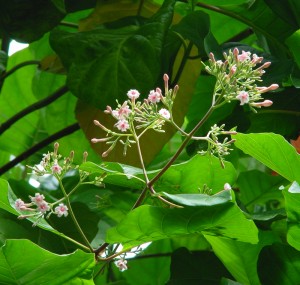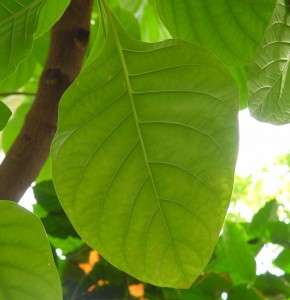The Cure for What Ails You
Posted in Interesting Plant Stories on September 14, 2015 by Christian Primeau
Christian Primeau is NYBG‘s Manager of the Enid A. Haupt Conservatory.

In my last blog post I examined coffee, the official beverage of NYC movers, shakers, and deal-makers and source of my favorite alkaloid, caffeine. This article is something of a sequel. While the consensus seems to be that a sequel is never as good as the original, I could muster a boatload of rabid Star Wars fans that would argue to the contrary. In any case, my sequel involves a frosty highball of fine aromatic gin, a juicy wedge of lime, and a comfortable seat in the shade—so how bad could it possibly be? The alternate ending is not so pleasurable—it features high fever, chills, profuse sweating, nausea, and a plethora of other equally objectionable symptoms. Intrigued? Confused? Let me elaborate.
Outside of a handful of plant geeks, most folks probably aren’t that familiar with trees of the genus Cinchona (pronounced “sin-cho-nah”). They are native to the tropical Andean region of South America with some species reaching north into Central America or west as far as French Polynesia. It’s a pretty tree by most standards. The big Cinchona pubescens in the Upland Rainforest house of the Conservatory bears large, soft, elliptic green leaves and attractive panicles of rose-pink flowers in spring. But truly—anyone can stand around and look pretty. What makes this tree so fascinating is what it can do.
Just as coffee plants (Coffea arabica) produce caffeine, an alkaloid that protects the plant from pests while simultaneously attracting seed disseminators, pollinators, and early morning meeting captives alike, Cinchona produces an alkaloid so incredibly significant it buoyed a vast and powerful colonial empire. I’m talking about a substance so singularly important some folks literally could not have survived without it. I know, it sounds like I’m describing caffeine again, but no. You’ll know this substance as quinine.
Quinine is synthesized by the Cinchona tree and most commonly extracted from the bark. Like most alkaloids, it is extremely bitter and therefore protects the plant from casual herbivory (being munched on). However, in addition to the unpalatable flavor, studies have proven that, like caffeine, ingestion of quinine disrupts the normal developmental processes of pest insect populations, ultimately leading to their demise. In other words, the Cinchona produces its own pesticide.

“I don’t molt—what does that have to do with me?” you may be wondering. Well, caffeine provides humans with a pleasant buzz in the morning, but quinine may ensure you actually live to enjoy future espressos and lattes—especially if you have a penchant for exploring tropical locales. You see, quinine possesses fever-reducing, painkilling, and anti-inflammatory properties but, most importantly, it kills the deadly, mosquito-borne Plasmodium parasite that causes malaria.
British soldiers posted to tropical India (a malaria hotspot) during the colonial era discovered it was easier to swallow one’s daily preventive dose of bitter quinine powder when mixed with sugar-sweetened soda water. This routine became so widespread that by the early 1870s the Schweppes Company began producing pre-mixed curative “tonic water.” Nobody knows quite for certain who the enterprising British soldier was who further enhanced the pleasure of taking this tonic by adding a liberal splash of his gin ration, but I would think his face should be on a coin or stamp…or something. Who’s with me? (I’ll start the petition). It was simply a matter of time before a refreshing wedge of fresh-picked Rangpur lime (Citrus × limonia) found its way into the mix. Thus the gin and tonic was born!
Winston Churchill certainly said it best when he stated that “the gin and tonic has saved more Englishmen’s lives and minds than all the doctors in the Empire.” Of course, while more modern medicines are now commonly used to treat malaria, there is not a bartender alive that I know of who can improve upon the classic gin and tonic. The waning days of this sweltering summer are certainly a perfect time to slow down, relax, and sip an icy cold one. In the interest of further cultivating a healthy life and mind, why not enjoy a calming stroll through the garden and Enid A. Haupt Conservatory? Stop by and see the venerable Cinchona to which so many owe a debt of gratitude. This tree and many thousands of other captivating plants await your discovery. Cheers!


As always, informative, witty, and well-written!
Thank you again, dear Christian.